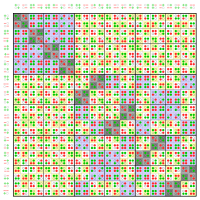Special linear group

Okay kiddo, imagine you have a really big room with a lot of toys in it. Now, you and your friends can do different things with those toys, but you always have to follow certain rules. Let's say one of those rules is that you have to keep all the toys on the floor, and you can't take them out of the room.
The "special linear group" is a bit like those rules in your toy room. It's a group of mathematical objects, called matrices, that have to follow certain rules too. But instead of playing with toys on the floor, these matrices are used to do math.
The matrices in the special linear group have some specific properties. For example, they have to be square (like a square piece of paper), and their "determinant" has to be 1 (which is a fancy way of saying that they're nicely behaved). There are lots of different matrices that meet these rules, but they all belong to the special linear group.
So, just like you and your friends can do different things with the toys in your room, mathematicians can use matrices from the special linear group to do all sorts of things. They can solve equations, study shapes, and even create cool computer graphics!
Overall, the special linear group might seem a bit complicated at first, but it's really just a set of rules that certain matrices have to follow. And just like the rules in your toy room make sure everyone can play together nicely, the rules in the special linear group help mathematicians do their work in a nice, organized way.
The "special linear group" is a bit like those rules in your toy room. It's a group of mathematical objects, called matrices, that have to follow certain rules too. But instead of playing with toys on the floor, these matrices are used to do math.
The matrices in the special linear group have some specific properties. For example, they have to be square (like a square piece of paper), and their "determinant" has to be 1 (which is a fancy way of saying that they're nicely behaved). There are lots of different matrices that meet these rules, but they all belong to the special linear group.
So, just like you and your friends can do different things with the toys in your room, mathematicians can use matrices from the special linear group to do all sorts of things. They can solve equations, study shapes, and even create cool computer graphics!
Overall, the special linear group might seem a bit complicated at first, but it's really just a set of rules that certain matrices have to follow. And just like the rules in your toy room make sure everyone can play together nicely, the rules in the special linear group help mathematicians do their work in a nice, organized way.
Related topics others have asked about:
